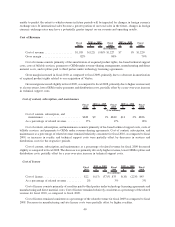Symantec 2010 Annual Report Download - page 125
Download and view the complete annual report
Please find page 125 of the 2010 Symantec annual report below. You can navigate through the pages in the report by either clicking on the pages listed below, or by using the keyword search tool below to find specific information within the annual report.infringes the intellectual property rights of a third party. Historically, payments made under these provisions have
been immaterial. We monitor the conditions that are subject to indemnification to identify if a loss has occurred.
Recently Adopted Authoritative Guidance
In the first quarter of fiscal 2010, we adopted new authoritative guidance on convertible debt instruments that
requires the issuer of convertible debt instruments with cash settlement features to separately account for the
liability and equity components of the instrument. The debt is recognized at the present value of its cash flows
discounted using the issuer’s nonconvertible debt borrowing rate at the time of issuance. The equity component is
recognized as the difference between the proceeds from the issuance of the note and the fair value of the liability.
This guidance also requires interest to be accreted as interest expense of the resultant debt discount over the
expected life of the debt. This guidance applies to the 0.75% Convertible Senior Notes due June 15, 2011 and the
1.00% Convertible Senior Notes due June 15, 2013, collectively referred to as the Senior Notes. Prior to the
adoption of this guidance, the liability of the Senior Notes was carried at its principal value and only the contractual
interest expense was recognized in our Consolidated Statements of Operations. Because this guidance requires
retrospective adoption, we were required to adjust all periods for which the Senior Notes were outstanding before
the date of adoption. See Note 1 of the Notes to Consolidated Financial Statements in this annual report for
additional information on the adoption.
In the first quarter of fiscal 2010, we adopted new authoritative guidance on business combinations that
requires an acquiring entity to measure and recognize identifiable assets acquired and liabilities assumed at the
acquisition date fair value with limited exceptions. The changes include the treatment of acquisition related
transaction costs, the valuation of any noncontrolling interest at acquisition date fair value, the recording of acquired
contingent liabilities at acquisition date fair value and the subsequent re-measurement of such liabilities after the
acquisition date, the recognition of capitalized in-process research and development, the accounting for acquisition-
related restructuring cost accruals subsequent to the acquisition date, and the recognition of changes in the
acquirer’s income tax valuation allowance. Our acquisitions during fiscal 2010 have been accounted for using this
new authoritative guidance. See Note 4 of the Notes to Consolidated Financial Statements in this annual report for
information on our business combinations. The adoption of this guidance did not have a material impact on our
consolidated financial statements, however, it could have a material impact on future periods.
In the first quarter of fiscal 2010, we adopted new authoritative guidance on the recognition and measurement
of other-than-temporary impairments for debt securities that replaced the pre-existing “intent and ability” indicator.
This guidance specifies that if the fair value of a debt security is less than its amortized cost basis, an
other-than-temporary impairment is triggered in circumstances in which (1) an entity has an intent to sell the
security, (2) it is more likely than not that the entity will be required to sell the security before recovery of its
amortized cost basis, or (3) the entity does not expect to recover the entire amortized cost basis of the security (that
is, a credit loss exists). Other-than-temporary impairments are separated into amounts representing credit losses,
which are recognized in earnings, and amounts related to all other factors, which are recognized in other
comprehensive income (loss). The adoption of this guidance did not have a material impact on our consolidated
financial statements.
In the first quarter of fiscal 2010, we adopted new authoritative guidance on noncontrolling (minority) interests
in consolidated financial statements, which includes requiring noncontrolling interests be classified as a component
of consolidated stockholders’ equity and to identify earnings attributable to noncontrolling interests reported as part
of consolidated earnings. The guidance also requires the gain or loss on the deconsolidated subsidiary be measured
using the fair value of the noncontrolling equity investment. The adoption of this guidance did not have a material
impact on our consolidated financial statements.
In the first quarter of fiscal 2010, we adopted new authoritative guidance that specifies the way in which fair
value measurements should be made for non-financial assets and liabilities that are not measured and recorded at
fair value on a recurring basis, and specifies additional disclosures related to these fair value measurements. The
adoption of this guidance did not have a material impact on our consolidated financial statements.
In the fourth quarter of fiscal 2010, we adopted new authoritative guidance on revenue recognition for
multiple-element arrangements. The new standard changes the requirements for establishing separate units of
49
























